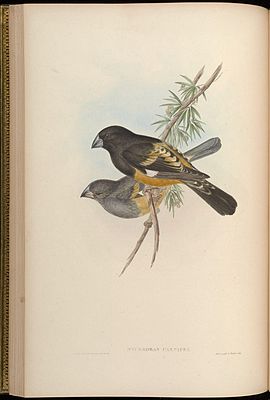Juniper grouse
| Juniper grouse | ||||||||||||
|---|---|---|---|---|---|---|---|---|---|---|---|---|

Juniper grouse ( Mycerobas carnipes ) |
||||||||||||
| Systematics | ||||||||||||
|
||||||||||||
| Scientific name | ||||||||||||
| Mycerobas carnipes | ||||||||||||
| ( Hodgson , 1836) |
The juniper grouse ( Mycerobas carnipes ) is a species from the goldfinch family . The species occurs exclusively in Asia. The IUCN classifies the juniper grouse as a non-endangered ( least concern ) species.
Appearance
The juniper grouse reaches a body length of 21 to 23 centimeters. As with the spotted , gold and yellow-thigh hawfinches , the male has a high proportion of black plumage on the upper side of the body. In contrast to these species of the genus Mycerobas , the male juniper grouse does not have any yellow plumage. His belly, lower and upper tail- coverts , the rump and a band on the wing covers are olive-green. The wings and tail feathers are also lined with olive green. The beak is typically massive and conical in shape. The beak color is silvery gray. There is a tooth-like notch on both sides of the upper beak.
The female has no black plumage. In her, the body parts that are colored black in the male are gray. The rest of the appearance resembles the male.
Way of life
The distribution area of the juniper grouse stretches from the northeast of Iran over the north of Afghanistan over the Himalayas to the southwest of China and the south of Mongolia . The juniper grouse is a distinctive high mountain species. It occurs mainly at altitudes between 2,500 and 4,000 meters.
The clutch comprises two to five eggs. The breeding season is 13 to 15 days. The female breeds alone. The young birds do not fly until after 22 to 25 days. After another two to three weeks, they are completely independent.
literature
- Horst Bielfeld : siskins, giraffe, bullfinches and grosbeak. Verlag Eugen Ulmer, Stuttgart 2003, ISBN 3-8001-3675-9 .
Individual evidence
Web links
- Photos of Mycerobas carnipes in the Oriental Bird Club image database , accessed March 26, 2010
- Mycerobas carnipes inthe IUCN 2013 Red List of Endangered Species . Listed by: BirdLife International, 2012. Retrieved September 10, 2013.